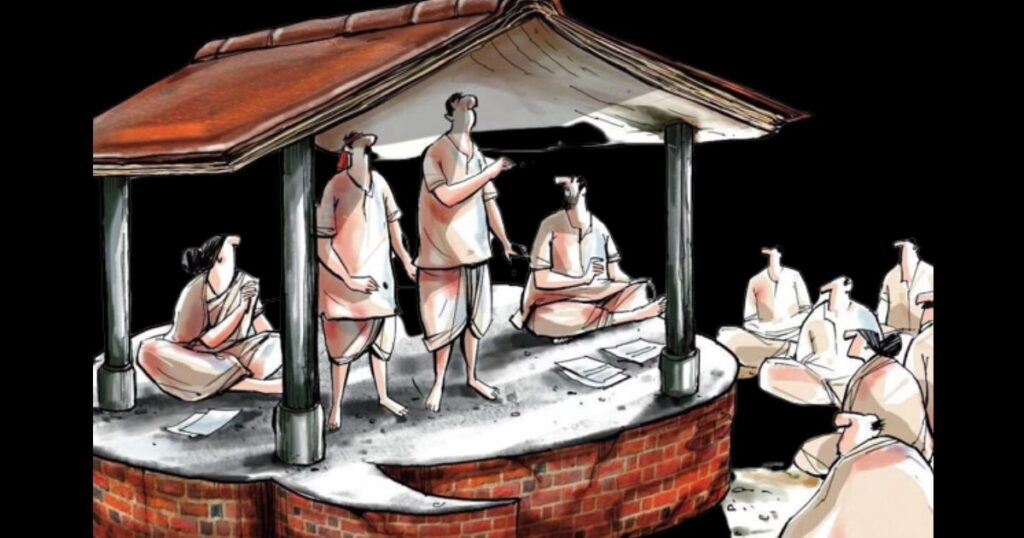Welcome to this article, the Panchayat Raj System in India during the British Era. where we will discuss into the history of Panchayat Raj. This decentralized governance system played a significant role in shaping India’s political landscape, and its historical context is essential to understanding its evolution and impact.
Key Takeaways:
- The Panchayat Raj System in India originated from ancient times and evolved over the centuries.
- The British rule in India had a profound influence on local governance, including policies and reforms related to the Panchayat Raj System.
- The impact of the 1857 Rebellion on the Panchayat Raj System was significant.
- The introduction of local self-government laws and the Government of India Acts of 1919 and 1935 brought about significant changes to the Panchayat Raj System.
- The Panchayat Raj System played a crucial role in India’s independence movement and underwent reforms after independence to strengthen its structure and functions.
Origins of Panchayat Raj System in India
The Panchayat Raj System has its roots in ancient India, where village councils or ‘sabhas’ were responsible for local governance. These sabhas were headed by the village elders and served as a platform for resolving disputes and making collective decisions.
Over time, the sabhas evolved into ‘panchayats,’ which consisted of five members chosen by the community. The panchayats were responsible for maintaining law and order, resolving disputes, and managing village affairs.
During the Mughal era, the panchayats continued to play a significant role in local governance, with the emperor appointing a ‘panch’ or a council of five members to oversee the administration of a district.
When the British arrived in India, they initially maintained the existing system of local governance. However, with the consolidation of their rule, they began to centralize power and introduce their own administrative structures.
Despite these changes, the Panchayat Raj System persisted in some parts of India and saw a revival during the Indian independence movement, where it served as a tool for political mobilization and resistance.
Origins of Panchayat Raj System in India

The origins of the Panchayat Raj System in India can be traced back to ancient times, where village councils or ‘sabhas’ served as the principal units of local governance. These sabhas were composed of the village elders and functioned as platforms for conflict resolution, administering justice, and making collective decisions.
Over time, the sabhas gave way to ‘panchayats,’ which comprised five members elected by the community. The panchayats held responsibility for maintaining law and order, presiding over local disputes, and managing village affairs. In some cases, the local king or ruler appointed a ‘panch’ or council of five officials to oversee the administration of a district.
The Mughal era further strengthened the Panchayat Raj System in India, where the emperor would authorize a ‘panch’ council to govern a particular region. The British, on the other hand, initially maintained the existing system of local governance but later introduced their own administrative structures.
Despite these changes, the Panchayat Raj System prevailed in some parts of India and played a vital role in shaping the country’s political landscape and history.
British Rule and Local Governance in India
British rule in India brought about significant changes in the governance structure, with a focus on modernization and centralization. The local governance system, including the Panchayat Raj System, was also affected by British policies and reforms.
During the early years of British rule in India, the Panchayat Raj System continued to function as a decentralized form of governance. However, as British influence and control increased, changes were made to the system to align it with the British model of governance.
The introduction of Local Self-Government Laws in the later years of British rule marked a significant shift in local governance. These laws aimed to provide a more organized and structured form of local governance, with elected representatives at different levels. The Panchayat Raj System was also brought under this new framework.
Under the Government of India Act, 1919, the Panchayat Raj System was recognized as a form of local self-government. However, it was limited in its scope and functions, and largely remained under the control of British officials.
You Can Read: Panchayat Raj System in India
British Rule and Local Governance in India
With the Government of India Act, 1935, the Panchayat Raj System was further developed and given a more significant role in local governance. It provided for greater autonomy and powers to the Panchayats, although they still remained subordinate to the British administration.
Despite these changes, the Panchayat Raj System remained a tool of British colonialism, serving their interests and not those of the local communities. The 1857 Rebellion had highlighted the need for a more representative and accountable form of governance, and the Panchayat Raj System did not fully meet these requirements.
Despite these limitations, the Panchayat Raj System played a significant role in India’s independence movement, serving as a platform for political mobilization and resistance. It also paved the way for the post-independence reforms, which aimed to strengthen and consolidate the system as a form of decentralized governance.
Today, the Panchayat Raj System remains an important part of India’s governance structure, providing a platform for local communities to participate in the decision-making process and address their socio-economic needs.
Panchayat Raj System During the Early British Period
The early years of British rule in India saw a significant impact on the traditional Panchayat Raj System. The British introduced their own governance system and laws, which greatly affected the functioning of the Panchayats.
Under the British, the Panchayats lost their powers and decision-making authority. The British administration saw the Panchayats as inefficient and corrupt, and thus they were stripped of their powers. The Panchayats were also deprived of their right to collect revenue and were made subservient to the British administration.
The British introduced their own revenue collection system and introduced new taxes, which led to the decline of the Panchayats. The system of taxation introduced by the British was complicated, and the Panchayats found it difficult to understand and implement.
Challenges Faced by the Panchayats
The Panchayats faced numerous challenges during the early British period. They were forced to pay tribute to the British government, which put a strain on their finances. The Panchayats were also forced to collect revenue on behalf of the British administration, which further weakened their financial position. The British also imposed their own laws, which were often at odds with the traditional laws of the Panchayats.
Despite these challenges, the Panchayats continued to function in some parts of India. They played a crucial role in maintaining law and order and resolving disputes in rural areas. However, their powers and authority were greatly reduced, and they became mere agents of the British administration.
Overall, the Panchayat Raj System during the early British period saw a significant decline in its functioning and authority. The British introduced their own governance system, which deprived the Panchayats of their powers and weakened their financial position. The Panchayats faced numerous challenges, but continued to function in some parts of India.
Impact of 1857 Rebellion on Panchayat Raj System
The 1857 rebellion, also known as the Indian Mutiny or First War of Indian Independence, had a significant impact on the Panchayat Raj System in India. The rebellion, which was the first large-scale resistance against British rule in India, shook the foundations of the colonial government and exposed its weaknesses.
The Panchayat Raj System, which was already suffering from neglect and fragmentation, was further weakened by the rebellion. Many of the local institutions that formed the backbone of the system were destroyed or disbanded, and the British authorities were forced to reorganize local governance in the aftermath of the rebellion.
One of the major impacts of the rebellion on the Panchayat Raj System was the establishment of a centralised bureaucracy that was responsible for managing local affairs. This led to the development of a more hierarchical system of governance, where power was concentrated in the hands of a few officials, rather than being distributed among local communities.
The rebellion also led to a shift in the approach of the British towards local governance. Prior to the rebellion, the British had largely relied on existing local institutions and elites to maintain law and order, while pursuing a policy of non-interference in local affairs. However, the rebellion made it clear that this approach was no longer feasible, and the British began to adopt a more interventionist approach towards local governance.
Despite these challenges, the Panchayat Raj System continued to play an important role in local governance in India, particularly in areas where the rebellion was not as widespread. The system provided a framework for local communities to come together and manage their own affairs, and many of the institutions that were destroyed during the rebellion were eventually rebuilt.
Introduction of Local Self-Government Laws

As British rule in India progressed, efforts were made to reform the local governance system. The introduction of local self-government laws marked a significant step towards decentralization and autonomy in local governance.
The first local self-government law, the Bengal Districts Act, was introduced in 1836. This Act established district-level committees that were responsible for a range of functions, including public works, education, and healthcare. The Act was later extended to other provinces in India.
Another significant local self-government law was the Madras Village Panchayat Act of 1884, which established village-level committees known as Panchayats. These committees were responsible for various aspects of village administration, including sanitation, public health, and dispute resolution. The concept of Panchayats gained popularity and was eventually adopted in other provinces as well.
Under the local self-government laws, the Panchayats and other committees were given a certain degree of autonomy and were responsible for their own administration, including revenue and expenditure. This autonomy was a significant departure from the centralization and bureaucratic system that had been in place prior to the introduction of these laws.
However, it should be noted that the local self-government laws were limited in scope and did not extend to all parts of India. Moreover, these laws were not uniform in their provisions and were subject to changes and amendments over time.
Panchayat Raj System Under the Government of India Act, 1919
The Government of India Act, 1919, marked a significant shift in the decentralization of power and authority in India. It introduced a new system of provincial autonomy, wherein elected representatives were granted greater powers to govern their regions. It was under this act that the Panchayat Raj System was first introduced as a form of local self-government.
The act provided for the establishment of village councils, called Panchayats, which were responsible for the local administration of their respective villages. The Panchayats were to be composed of elected representatives, who would be appointed through a process of direct election. The act also provided for the appointment of a local officer, known as the Sarpanch, who was to be responsible for the overall management and supervision of the Panchayat.
The Panchayat Raj System under the Government of India Act, 1919, had limited powers and functions. It was primarily responsible for the management of local affairs, such as sanitation, health, and education. The system had no legislative or executive powers, and its decisions were subject to the approval of higher authorities.
However, the introduction of the Panchayat Raj System was a significant step towards the decentralization of power and the promotion of local self-government in India. It paved the way for subsequent reforms and developments in the Panchayat Raj System, ultimately leading to its constitutional recognition and consolidation after India’s independence.
Panchayat Raj System Under the Government of India Act, 1935
The Government of India Act, 1935, was a significant landmark in the history of the Panchayat Raj System in India. The act introduced a three-tier system of local self-government, consisting of village panchayats, taluk boards, and district boards. This was a marked departure from the earlier laws, which had given limited autonomy to local bodies.
Under the new scheme, village panchayats were to be responsible for local infrastructure, sanitation, and welfare activities. Taluk boards were to oversee development projects and planning within a group of villages, while district boards were to focus on regional issues such as roads, education, and healthcare.
The Government of India Act, 1935, also gave elected representatives a more prominent role in local governance. Village panchayat members were to be elected by adult male residents of the village, while taluk and district boards were to be elected by indirect election.
However, the act was not without its flaws. The provisions for indirect election meant that the rural elites retained a disproportionate amount of power, while the British authorities retained the right to dissolve local bodies at will.
Despite these shortcomings, the Government of India Act, 1935, marked a significant step forward in the evolution of the Panchayat Raj System. It laid the groundwork for the post-independence reforms that would make the system more democratic, accountable, and responsive to the needs of the people.
Role of Panchayat Raj System in India’s Independence Movement

During India’s struggle for independence, the Panchayat Raj System played a crucial role in mobilizing people against British rule. The local self-government system provided a platform for political activism and resistance, which ultimately led to the downfall of the British Empire in India.
The Panchayat Raj System was instrumental in nurturing a sense of community and solidarity among the masses. The system gave voice to the people and allowed them to participate in the decision-making process. The leaders of the Indian Independence Movement, such as Mahatma Gandhi, Jawaharlal Nehru, and Sardar Patel, recognized the importance of decentralized governance and actively promoted the Panchayat Raj System as a means of achieving independence.
“The Panchayat Raj is a decentralization of authority, and it has come to stay. We want the fullest development of the Panchayat Raj institutions, not only as a means of democratization but also as a means of efficient administration.” – Jawaharlal Nehru
The Panchayat Raj System was utilized to organize protests, boycotts, and other forms of civil disobedience against British rule. It also facilitated the spread of revolutionary ideas and ideologies throughout the country. The leaders of the Indian Independence Movement recognized the potential of the Panchayat Raj System to bring about social and political change, and they worked tirelessly to ensure its success.
The Panchayat Raj System gave people a sense of ownership and responsibility towards their communities. It allowed for the development of local leadership, which ultimately contributed to the success of the Indian Independence Movement. Even after India became independent, the Panchayat Raj System continued to play an important role in nation-building and in the development of a democratic and decentralized governance system.
Post-Independence Reforms and Consolidation of Panchayat Raj System
After gaining independence from British rule, India embarked on a series of reforms to strengthen and consolidate the Panchayat Raj System. The first major step was taken with the enactment of the Community Development Program (CDP) in 1952, which aimed at rural development through community participation.
Subsequently, the Panchayati Raj institutions were given constitutional recognition in 1992 through the 73rd Constitutional Amendment Act, which mandated a three-tier structure of Panchayats – Gram Panchayat at the village level, Panchayat Samiti at the block level, and Zilla Parishad at the district level.
These institutions were given the power to plan and execute various development schemes and programs at the local level, and were also entrusted with the responsibility of collecting and managing resources. This has led to a significant increase in the participation of common people in the democratic process and has helped in the upliftment of rural communities.
However, the Panchayat Raj System still faces various challenges such as inadequate financial and administrative resources, lack of trained personnel, and political interference. Efforts are being made to address these issues through various reforms and capacity building measures.
Modern-Day Panchayat Raj System in India
The Panchayat Raj System in India has come a long way since its inception during the British Era. Today, it serves as a crucial element of India’s democratic setup, providing a decentralized mode of governance at the grassroots level.
The modern-day Panchayat Raj System in India comprises three tiers of local governance bodies – Gram Panchayats (village level), Panchayat Samitis (block level), and Zila Parishads (district level). These bodies are responsible for a range of functions, including rural development, social justice, infrastructure development, and community welfare, among others.
Since the 73rd Constitutional Amendment Act of 1992, which granted constitutional status to Panchayats, there have been several reforms and initiatives aimed at strengthening and enhancing their role in India’s development. One such initiative is the e-Panchayat Mission Mode Project, launched in 2008 to digitize and streamline the functioning of Panchayats across the country.
However, the modern-day Panchayat Raj System in India also faces several challenges, such as inadequate funding and resources, lack of autonomy, and political interference. Nevertheless, it continues to be a vital mechanism for ensuring decentralized and inclusive governance in India, particularly in its rural hinterlands.
Conclusion
In conclusion, the Panchayat Raj System in India during the British Era was a decentralized governance system that played a significant role in shaping the country’s political and social landscape. The origins of this system can be traced back to ancient times, but it underwent several changes and developments over the centuries, particularly during British rule.
The early years of British rule saw the Panchayat Raj System undergo challenges and changes due to various factors such as administrative reforms and the impact of the 1857 Rebellion. However, during the later years, the British introduced local self-government laws, which significantly affected the Panchayat Raj System.
Under the Government of India Act of 1919, the Panchayat Raj System was given constitutional recognition, which further strengthened its role in local governance. The Government of India Act of 1935 brought about significant changes and developments to the system, including the creation of village panchayats, which served as the lowest tier of the governance hierarchy.
The Panchayat Raj System played a crucial role in India’s independence movement, serving as a platform for political mobilization and resistance. Post-independence, several reforms were undertaken to consolidate and strengthen the system, resulting in its constitutional recognition and subsequent changes.
The modern-day Panchayat Raj System in India has evolved to become a three-tier structure consisting of Gram Panchayat at the village level, Mandal or Block Panchayat at the intermediate level, and Zila Panchayat at the district level. Although it faces several challenges, such as inadequate resources and limited participation of women and marginalized communities, the system remains an essential component of India’s democracy.
In summary, the Panchayat Raj System in India during the British Era was a crucial period that shaped the system’s historical significance and impact in the country. Its evolution over the centuries and the changes brought about by British rule and subsequent reforms have resulted in a system that plays a crucial role in local governance and democracy in India.
FAQ
Q: What is the background of the Panchayat Raj System in India during the British Era?
A: The Panchayat Raj System in India during the British Era emerged as a decentralized governance system. It played a crucial role in local self-governance and had its historical significance.
Q: Where did the Panchayat Raj System in India originate from?
A: The origins of the Panchayat Raj System in India can be traced back to ancient times. Over the centuries, it evolved into a structured system of local governance.
Q: How did British rule influence local governance in India?
A: British rule had a significant impact on local governance in India. The British implemented policies and reforms, including changes to the Panchayat Raj System, which shaped the administrative structure.
Q: What was the state of the Panchayat Raj System during the early British period?
A: During the early years of British rule in India, the Panchayat Raj System underwent changes and faced challenges. This period marked significant transitions within the governance system.
Q: What was the impact of the 1857 Rebellion on the Panchayat Raj System?
A: The 1857 Rebellion had an impact on the Panchayat Raj System. It led to repercussions that affected local governance in India, including changes within the structure and functioning of the system.
Q: How were local self-government laws introduced in India?
A: The British introduced local self-government laws during the later years of their rule in India. These laws aimed to decentralize power and affected the operation of the Panchayat Raj System.
Q: What were the provisions and implications of the Panchayat Raj System under the Government of India Act, 1919?
A: The Panchayat Raj System underwent provisions and implications under the Government of India Act, 1919. This Act defined the structure and powers of local self-governance.
Q: How did the Panchayat Raj System evolve under the Government of India Act, 1935?
A: The Panchayat Raj System underwent changes and developments under the Government of India Act, 1935. This Act brought significant amendments and reforms that shaped the local governance structure.
Q: What role did the Panchayat Raj System play in India’s independence movement?
A: The Panchayat Raj System played a crucial role in India’s independence movement. It served as a platform for political mobilization and resistance against British rule.
Q: What reforms were implemented to strengthen and consolidate the Panchayat Raj System after India’s independence?
A: After India’s independence, several reforms were undertaken to strengthen and consolidate the Panchayat Raj System. These reforms included constitutional recognition and subsequent changes.
Q: What is the current state of the Panchayat Raj System in India?
A: The modern-day Panchayat Raj System in India functions as a decentralized governance system. It faces various challenges in terms of structure, functions, and implementation.
Q: What is the significance of the Panchayat Raj System in India during the British Era?
A: The Panchayat Raj System in India during the British Era holds historical significance. It played a crucial role in local self-governance and influenced the evolution of the administrative structure.











1 thought on “Panchayat Raj System in India during British Era”